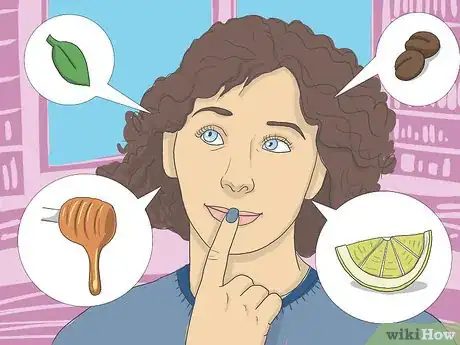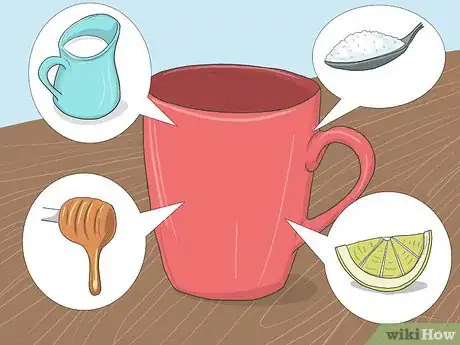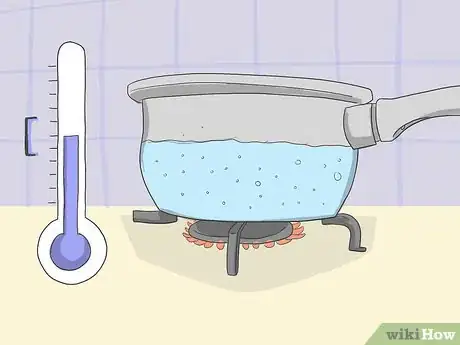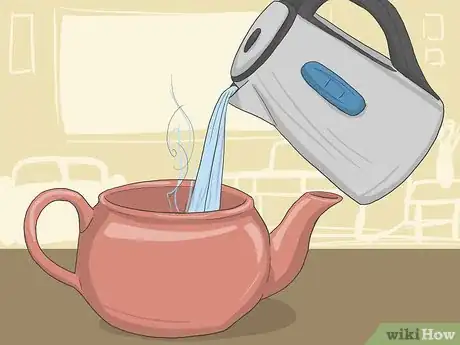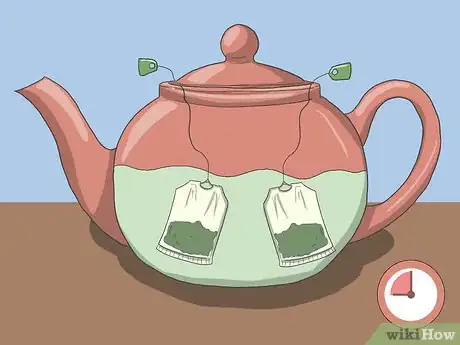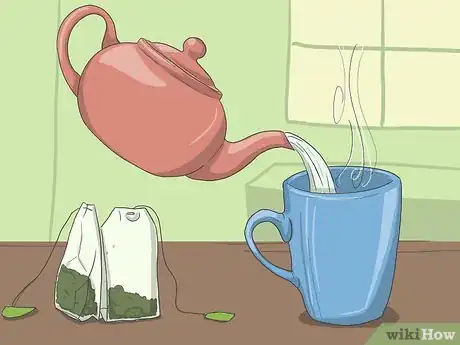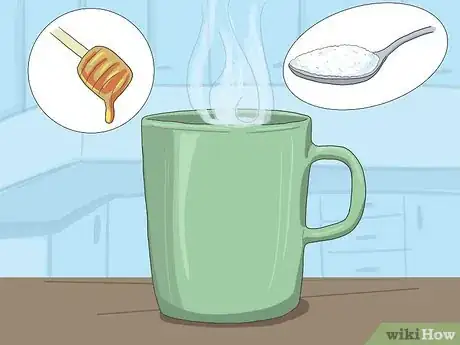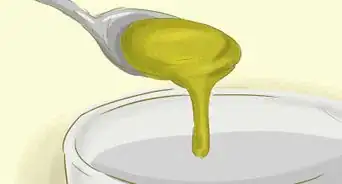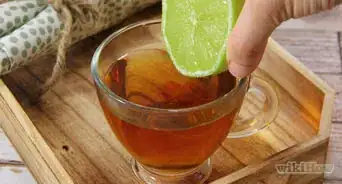wikiHow is a “wiki,” similar to Wikipedia, which means that many of our articles are co-written by multiple authors. To create this article, 21 people, some anonymous, worked to edit and improve it over time.
There are 9 references cited in this article, which can be found at the bottom of the page.
This article has been viewed 126,114 times.
Learn more...
Drinking hot tea is a wonderful way to relax, hydrate, and benefit your health. There are many different types of teas to choose from to appease your taste. If tea is a bit too bitter for you, you can add flavor with spices and sweeteners. When you steep tea at the right temperature and for the correct amount of time, you will end up with the perfect cup of delicious tea, or cuppa if you're British.
Steps
Choosing a Tea
-
1Choose a tea based on its health benefits. Teas provide many health benefits when you consume them. Different teas provide different benefits such as lowering cholesterol or helping to ease your stress. Consider why you want to enjoy a cup of tea, and pick a tea that will provide the added benefits you want.[1]
- Green tea has a high amount of antioxidants and may help to prevent certain types of cancer. It also is said to help burn fat, improve cholesterol levels, and reduce the effects of stress on the body.
- Black tea, depending on the quality, may help relieve stress, lower cholesterol levels, improve heart health, etc.
- White tea, depending on its quality, is high in antioxidants.
- Fruit teas offer a huge variety and are a good alternative to soda.
-
2Decide how much caffeine you want. True teas from the Camilla Sinensis plant contain caffeine. These are black tea, oolong tea, green tea, white tea, and more. The amount of caffeine varies depending on the tea and brewing process, but it typically ranges from 15-70 milligrams in an 8-ounce cup. There are also decaffeinated teas available which typically contain 98 percent less caffeine than regular teas; an 8-ounce cup of decaffeinated tea usually has around 2 mg or less of caffeine. Herbal teas are typically caffeine-free, and a great choice for drinking at night.[2]
- Many tea brands will list the caffeine amount on their product or website.
Advertisement -
3Pick flavor additives or sweetener. Some teas, like green tea, are quite bitter and hard for some people to drink plain. There are many things you can add to your tea to change the flavor and make it a little sweeter. Try adding some spices to change the flavor of your morning tea, or add a touch of something sweet to enhance the tea.[3]
- Use a cinnamon stick to stir your tea to add a spicy kick
- Milk or cream is a popular additive to tea. This quickly cools off the tea as well as adds a creamy feel to your cup. Dairy alternatives like almond, soy, or coconut milk work great too. Milk may curdle if added to teas such as Earl Grey that contain citrus oils.
- Lemon is a great addition to any type of black tea.
- Sweeten bitter green teas with a small amount of maple syrup, raw sugar, or honey for a yummy treat.
Brewing the Tea
-
1Boil a pot of water. Add fresh, cold water to a medium-sized pot or a tea kettle that can be heated on the stove. Place the pot or tea kettle over high heat to get the water to boil. Remove the pot or kettle from the heat as soon as the water begins to boil. Different teas require different temperatures of water to steep correctly, so make sure you know what type of tea you plan to brew. You may also use an electric kettle if you wish.[4] [5]
- Black tea can steep in water that is at the boiling point 200-212º F.
- Green and white teas are more delicate and will burn if steeped in water that’s too hot. For these teas, take the water off the heat just before the point of boiling, or before steeping, let the water sit for some time to cool down after boiling. Green tea should be steeped in water between 160º-180ºF. White Tea requires cooler water at 175º F.
- A meat or cooking thermometer can help you determine the temperature of the water.
-
2Pour water into a teapot. When the water is at the appropriate temperature for the tea you’re brewing, pour the water into the container that you’ll steep the tea in. There are different types of teapots made from different materials like iron, glass, or porcelain. It's okay to use a teabag in a mug if that is what you are in the mood for.
- Some materials like iron keep the heat longer and are great for teas that need higher heat, and some materials like porcelain lose heat quicker and are better for the more delicate teas.
- Adding boiling water to a cold container will lower the temperature of the water. Make sure your water is at the proper temperature in your teapot. Use caution when adding boiling water to glass or porcelain as the sudden temperature change may crack the glass.
- If you are brewing a single cup of tea, you can add the hot water directly to the mug you plan to drink the tea from.
-
3Add the tea to the teapot. Once your hot water is in the appropriate container, you can add the leaves to the water. You can add the tea in tea bags or a tea infuser as well. This will make removing the tea easier, however steeping the tea leaves freely in the teapot sometimes gives a stronger, fuller flavor.
-
4Steep for the appropriate amount of time. The biggest mistake people make when making hot tea is over steeping the tea. If you steep the tea too long it loses its flavor and becomes very bitter. Different teas need to steep for different amounts of time so be sure to pay attention to the amount of time your tea is steeping.[6] [7]
- White tea should steep 1 to 3 minutes.
- Green tea should steep 3 minutes.
- Oolong and black tea should steep 3-5 minutes.
- Many tea manufactures put the suggested steep time on the product’s packaging or their website so check to find out your specific tea’s steep time before making the tea.
-
5Remove the tea from the teapot and pour it into cups. Before pouring the tea into the cups, you need to remove the tea. If you used tea bags or a tea infuser to steep your tea, you can simply remove the bags or infuser from the teapot and then pour the tea. If you’ve steeped tea leaves directly in the teapot, you’ll need to strain the tea first. Pour the tea through a strainer as you add it to the teacups.
Drinking the Tea
-
1Add in flavors and sweeteners. Stir in your choice of added sweetener or flavor to your tea before drinking. Stir until the sweetener is fully dissolved so that it's evenly distributed in your cup.
-
2Let the tea cool down before drinking. It’s important to let your tea cool down some before drinking to avoid injury. Drinking tea that is too hot can burn your tongue or the inside of your mouth. Constant consumption of extremely hot tea has been linked to an increased risk of esophageal cancer, so it’s extremely important to let your tea cool down a bit before consuming it.[8]
-
3Enjoy sipping your tea. When your tea has cooled down, it’s time to enjoy it. Breathe in deep and experience the aroma of the tea before you take your first sip. Sip your tea knowing that you’re doing something healthy for your body giving it some much-needed hydration. Relax with your cup of tea as you give your body a rush of antioxidants and boost your health.[9]
Community Q&A
-
QuestionHow can I test my tea without tasting it?
 Community AnswerBy taking a long deep breath of the tea, you can smell the fragrance and test the tea that way.
Community AnswerBy taking a long deep breath of the tea, you can smell the fragrance and test the tea that way. -
QuestionIs it okay if I pour the hot water directly into the cup with the tea bag, wait and drink it?
 Community AnswerYes, you could do that. The other steps are ceremonial, for the most part.
Community AnswerYes, you could do that. The other steps are ceremonial, for the most part. -
QuestionI don't want to wait too long because I need to drink it quickly before a party. What do I do?
 Community AnswerAdd cold water to the tea to cool it off after it has brewed in hot water.
Community AnswerAdd cold water to the tea to cool it off after it has brewed in hot water.
Warnings
- Boiling water is extremely hot and can severely burn you. Use caution when heating water and pouring boiling water.⧼thumbs_response⧽
- There hasn’t been a lot of studies done on herbal teas and their effects on people. Use caution when using herbal teas to ensure you don’t consume something that might harm your health.⧼thumbs_response⧽
- Make sure your tea comes from a reliable source that you trust. Some teas are grown or decaffeinated with the use of chemicals that may be harmful to your health.⧼thumbs_response⧽
References
- ↑ http://www.webmd.com/diet/tea-types-and-their-health-benefits.
- ↑ http://ratetea.com/topic/caffeine-content-of-tea/21/
- ↑ http://www.treehugger.com/green-food/8-ways-spice-your-morning-coffee-or-tea.html
- ↑ http://the.republicoftea.com/library/how-to-make-tea/how-to-brew-hot-tea/
- ↑ http://www.independent.co.uk/life-style-food-and-drink/news/hot-to-make-the-perfect-cup-of-tea-british-standars-institution-issues-new-guide-10050692.html
- ↑ http://www.bonappetit.com/drinks/non-alcoholic/article/tea-steeping-guide
- ↑ www.finedininglovers.com/stories/english-tea-tips-rules/
- ↑ http://www.webmd.com/cancer/news/20090326/hot-tea-may-raise-esophageal-cancer-risk
- ↑ http://healthland.time.com/2012/09/04/13-reasons-to-love-tea/
About This Article
To drink hot tea, start by choosing a tea based on its health benefits. For example, green and white teas have antioxidants, while black tea can lower cholesterol levels. Next, decide how much caffeine you want, as a cup of tea can vary between 2 and 70 milligrams of caffeine per cup. Once you’ve chosen your tea, boil a pot of water and pour the hot water into a teapot or a teacup. Then, add the tea to the hot water, and steep it for 1-5 minutes, depending on the type of tea and how strong you want the flavor. To learn how to pick flavor additives or sweeteners for your tea, keep reading!
